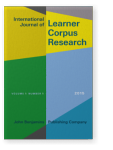Alexopoulou, Theodora, Marije Michel, Akira Murakami & Detmar Meurers
2017.
Task Effects on Linguistic Complexity and Accuracy: A Large‐Scale Learner Corpus Analysis Employing Natural Language Processing Techniques.
Language Learning 67:S1
► pp. 180 ff.

Allaw, Elissa
2021.
A learner corpus analysis: Effects of task complexity, task type, and L1 & L2 similarity on propositional and linguistic complexity
.
International Review of Applied Linguistics in Language Teaching 59:4
► pp. 569 ff.

Bell, Philippa, Laura Collins & Emma Marsden
2020.
Building an Oral and Written Learner Corpus of a School Programme: Methodological Issues. In
Learner Corpus Research Meets Second Language Acquisition,
► pp. 214 ff.

Bruyn, Bert Le & Magali Paquot
2020.
Learner Corpus Research and Second Language Acquisition: an attempt at bridging the gap. In
Learner Corpus Research Meets Second Language Acquisition,
► pp. 1 ff.

Buyse, Kris, Lydia Fernández Pereda & Katrien Verveckken
Domínguez, Laura, María J Arche & Florence Myles
2017.
Spanish Imperfect revisited: Exploring L1 influence in the reassembly of imperfective features onto new L2 forms.
Second Language Research 33:4
► pp. 431 ff.

Fernández, Julieta
2023.
Pragmatics in Learner Corpora. In
The Encyclopedia of Applied Linguistics,
► pp. 1 ff.

Fernández-Mira, Paloma, Emily Morgan, Sam Davidson, Aaron Yamada, Agustina Carando, Kenji Sagae & Claudia H. Sánchez-Gutiérrez
Fuchs, Robert & Valentin Werner
Fuchs, Robert & Valentin Werner
Gablasova, Dana, Vaclav Brezina & Tony McEnery
2017.
Exploring Learner Language Through Corpora: Comparing and Interpreting Corpus Frequency Information.
Language Learning 67:S1
► pp. 130 ff.

Gablasova, Dana, Vaclav Brezina & Tony McEnery
Gudmestad, Aarnes
2022.
Development of grammar, vocabulary, and pragmatics in an additional language: insights from Spanish learner corpus research.
Journal of Spanish Language Teaching 9:2
► pp. 161 ff.

Gudmestad, Aarnes, Amanda Edmonds & Thomas Metzger
2019.
Using Variationism and Learner Corpus Research to Investigate Grammatical Gender Marking in Additional Language Spanish.
Language Learning 69:4
► pp. 911 ff.

Gujord, Ann-Kristin Helland, Åshild Søfteland & Linda Evenstad Emilsen
2023.
Å forske på språkutviklinga hos innlærere med begrensa skolebakgrunn – metodiske valg og problemstillinger.
Nordand 18:2
► pp. 125 ff.

Iurato, Alessia
2022.
Learner Corpus Research Meets Chinese as a Second Language Acquisition: Achievements and Challenges
.
Annali di Ca’ Foscari. Serie orientale :1

Karges, Katharina, Thomas Studer & Nina Selina Hicks
2022.
Lernersprache, Aufgabe und Modalität: Beobachtungen zu Texten aus dem Schweizer Lernerkorpus SWIKO.
Zeitschrift für germanistische Linguistik 50:1
► pp. 104 ff.

Kerz, Elma, Stella Neumann & Paula Niemietz
Kreyer, Rolf & Steffen Schaub
Lozano, Cristóbal
2022.
CEDEL2: Design, compilation and web interface of an online corpus for L2 Spanish acquisition research.
Second Language Research 38:4
► pp. 965 ff.

Lozano, Cristóbal & Marcus Callies
2018.
Word Order and Information Structure in Advanced SLA. In
The Handbook of Advanced Proficiency in Second Language Acquisition,
► pp. 419 ff.

Lozano, Cristóbal & Ana Díaz-Negrillo
Lozano, Cristóbal & Paloma Fernández-Mira
2022.
Designing, compiling and interrogating corpora in L2 Spanish acquisition research.
Journal of Spanish Language Teaching 9:2
► pp. 190 ff.

López-Beltrán, Priscila, Michael A Johns, Paola E Dussias, Cristóbal Lozano & Alfonso Palma
2022.
The effects of information structure in the processing of word order variation in the second language.
Second Language Research 38:3
► pp. 639 ff.

Mendikoetxea, Amaya & Cristóbal Lozano
2018.
From Corpora to Experiments: Methodological Triangulation in the Study of Word Order at the Interfaces in Adult Late Bilinguals (L2 learners).
Journal of Psycholinguistic Research 47:4
► pp. 871 ff.

Minnillo, Sophia, Claudia Sánchez-Gutiérrez, Ana Ruiz-Alonso-Bartol, Emily Morgan & Carmen González Gómez
Myles, Florence
2020.
Commentary: An SLA Perspective on Learner Corpus Research. In
Learner Corpus Research Meets Second Language Acquisition,
► pp. 258 ff.

Paquot, Magali
2024.
Learner corpus research: a critical appraisal and roadmap for contributing (more) to SLA research agendas.
Corpus Linguistics and Linguistic Theory 0:0

Paquot, Magali & Nicole Tracy‐Ventura
2023.
Using Foreign and Second Language Learner Corpora. In
Current Approaches in Second Language Acquisition Research,
► pp. 96 ff.

Sánchez-Gutiérrez, Claudia, Barbara De Cock & Nicole Tracy-Ventura
2022.
Spanish corpora and their pedagogical uses: challenges and opportunities.
Journal of Spanish Language Teaching 9:2
► pp. 105 ff.

Tracy-Ventura, Nicole & Jhon A. Cuesta Medina
Tracy-Ventura, Nicole & Jhon A. Cuesta Medina
Tracy-Ventura, Nicole, Rosamond Mitchell & Kevin McManus
Weiss, Zarah & Detmar Meurers
Wisniewski, Katrin
2017.
Empirical Learner Language and the Levels of the Common European Framework of Reference.
Language Learning 67:S1
► pp. 232 ff.

Wisniewski, Katrin
2021.
„Ist es B2-Niveau genug?“.
Zeitschrift für Angewandte Linguistik 2021:75
► pp. 364 ff.

Wisniewski, Katrin
2022.
Gesprochene Lernerkorpora des Deutschen: Eine Bestandsaufnahme.
Zeitschrift für germanistische Linguistik 50:1
► pp. 1 ff.

Zeng, Xiaoyan, Yasuhiro Shirai & Xiaoxiang Chen
2021.
Universals and transfer in the acquisition of the progressive aspect: Evidence from L1 Chinese, German, and Spanish learners’ use of the progressive-ingin spoken English.
International Review of Applied Linguistics in Language Teaching 59:2
► pp. 267 ff.

Zeng, Xiaoyan, Yasuhiro Shirai & Xiaoxiang Chen
2023.
A corpus-based study of the acquisition of the English progressive by L1 Chinese learners: from prototypical activities to marked statives.
Linguistics 61:3
► pp. 749 ff.

Zhao, Helen & Yasuhiro Shirai
Zhao, Helen & Yasuhiro Shirai
This list is based on CrossRef data as of 1 june 2024. Please note that it may not be complete. Sources presented here have been supplied by the respective publishers.
Any errors therein should be reported to them.
